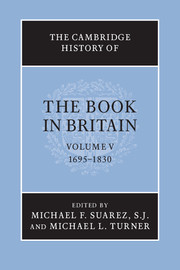Book contents
- Frontmatter
- Introduction
- PART I THE QUANTITY AND NATURE OF PRINTED MATTER
- PART II ECONOMIC, LEGAL AND CULTURAL CONTEXTS
- PART III THE TECHNOLOGIES AND AESTHETICS OF BOOK PRODUCTION
- PART IV THE BOOK TRADE AND ITS MARKETS
- I LONDON AND THE ‘COUNTRY’
- 13 London and the central sites of the English book trade
- 14 Personnel within the London book trades: evidence from the Stationers’ Company
- 15 The English provincial book trade: evidence from the British book trade index
- 16 The Scottish book trade
- 17 The Irish trade
- II TWO CASE STUDIES
- III SERIAL PUBLICATION AND THE TRADE
- IV THE INTERNATIONAL MARKET
- V BOOKS AND THEIR READERS
- Abbreviations used in bibliography
- Bibliography
- Index
- Frontispiece
- Plate section
- References
13 - London and the central sites of the English book trade
from I - LONDON AND THE ‘COUNTRY’
Published online by Cambridge University Press: 28 September 2010
- Frontmatter
- Introduction
- PART I THE QUANTITY AND NATURE OF PRINTED MATTER
- PART II ECONOMIC, LEGAL AND CULTURAL CONTEXTS
- PART III THE TECHNOLOGIES AND AESTHETICS OF BOOK PRODUCTION
- PART IV THE BOOK TRADE AND ITS MARKETS
- I LONDON AND THE ‘COUNTRY’
- 13 London and the central sites of the English book trade
- 14 Personnel within the London book trades: evidence from the Stationers’ Company
- 15 The English provincial book trade: evidence from the British book trade index
- 16 The Scottish book trade
- 17 The Irish trade
- II TWO CASE STUDIES
- III SERIAL PUBLICATION AND THE TRADE
- IV THE INTERNATIONAL MARKET
- V BOOKS AND THEIR READERS
- Abbreviations used in bibliography
- Bibliography
- Index
- Frontispiece
- Plate section
- References
Summary
New building schemes, new commercial agendas and new trading practices reshaped the topography of the London book trade between 1695 and 1830. Fixed sites of sale increasingly replaced (but by no means completely supplanted) itinerant traders supplied by cheap book depots. Greater book-trade concentrations in particular streets and precincts supported new trade specializations. Bookshops, printing houses and subscription and commercial libraries followed developers and builders as fashionable London devoured the fields to the west and north of the City. As is often the case, change, especially rapid change, also highlighted continuities and encouraged the exploitation of tradition.
Mapping the location of printers, booksellers and allied businesses deepens our understanding of the commercial and cultural orientation of the book trade between the late seventeenth and the mid-nineteenth centuries. As the following seeks to demonstrate, the business of publishing and bookselling, characterized by increasing diversity and a steady expansion of production, was closely allied to the transformation of London during this period. From a relatively modest European capital city, London became an imperial metropolis. The compact clusters of streets and public spaces within the medieval walls turned into the nucleus of a sprawling conglomerate of different neighbourhoods. The practical (if not administrative) fusion of London, Westminster and Southwark during the eighteenth century stretched from the elegance of western and northern squares to the wharves and squalor of the East End, to the workshops and market gardens south of the Thames. By means of its products – and notably by books and periodicals – London was highly visible to the country at large. Commentators acclaimed the flow of goods in and out of the city as a marvel of the age. As John Macky noted in the 1720s, London boasted open gates rather than being encircled by continental-style bastions.
- Type
- Chapter
- Information
- The Cambridge History of the Book in Britain , pp. 291 - 308Publisher: Cambridge University PressPrint publication year: 2009
References
- 2
- Cited by

